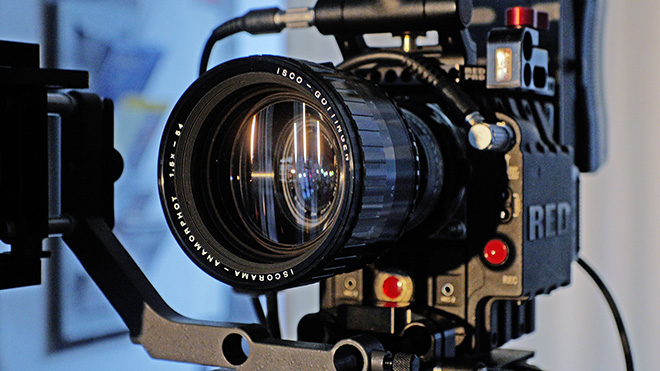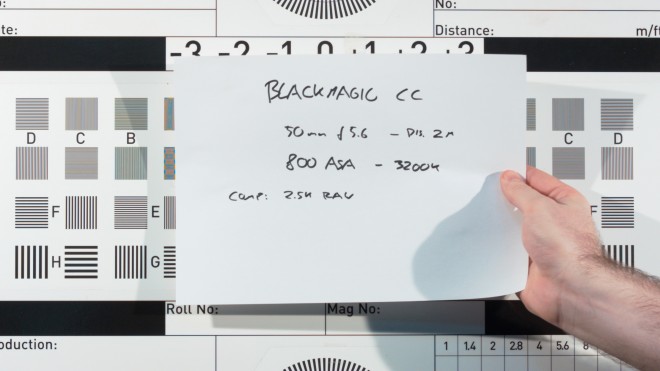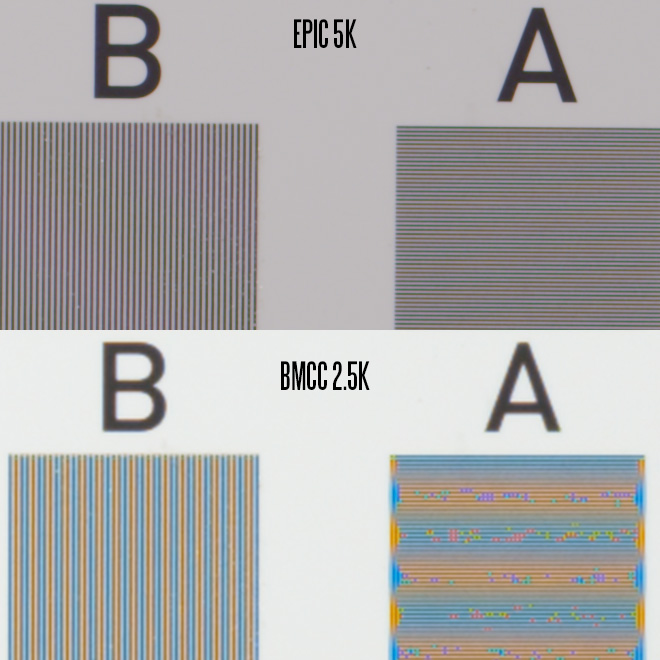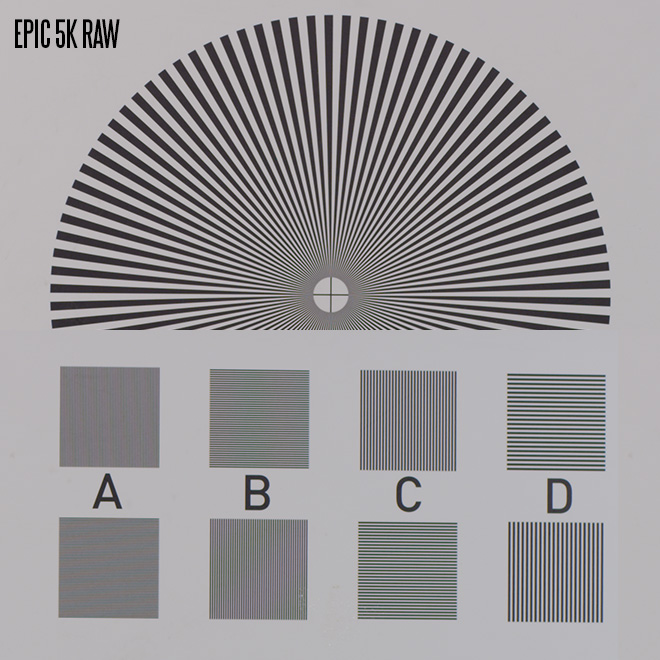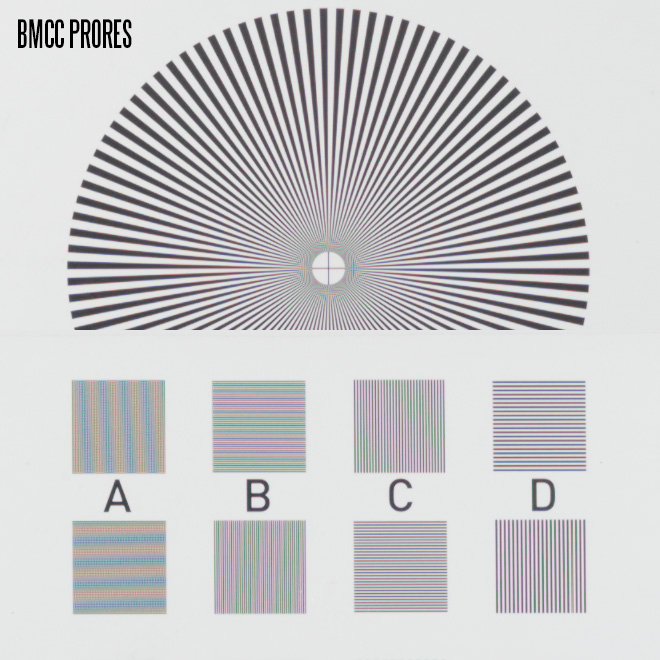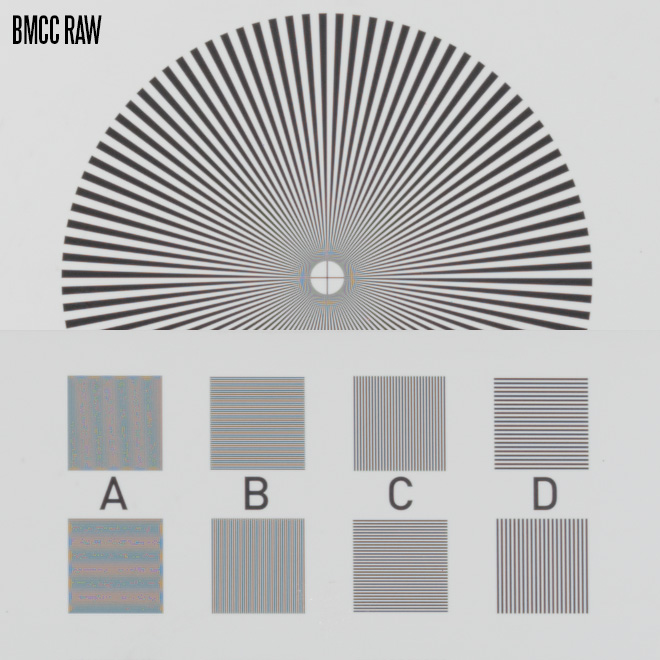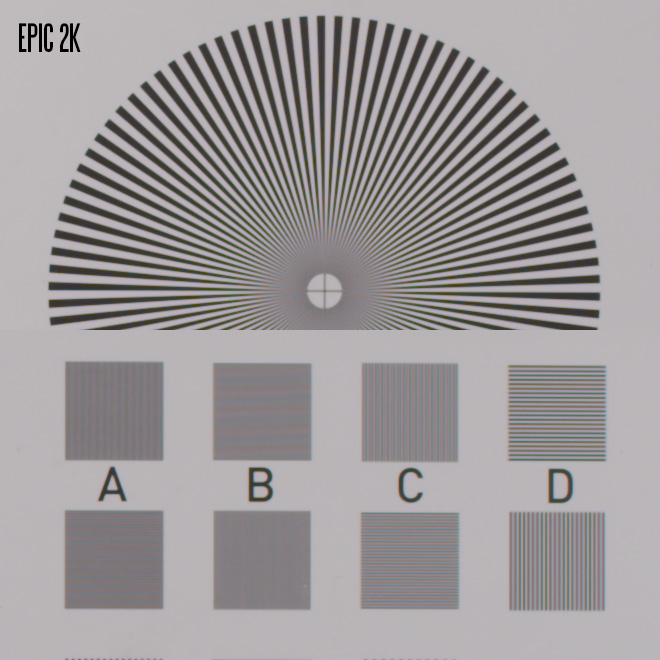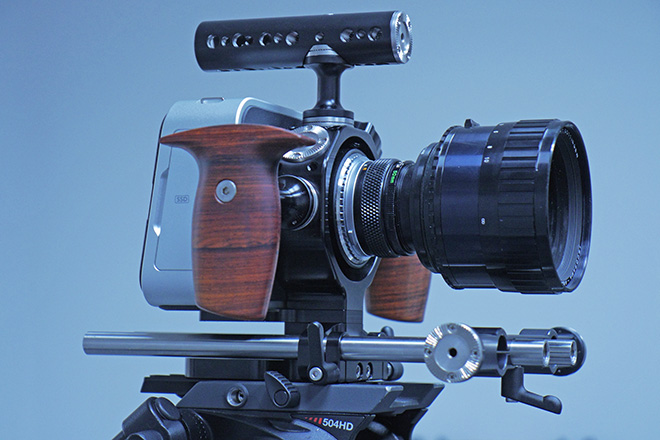Above: the Epic with anamorphic lens
In the second and final part of this mini-shootout with the Epic and Blackmagic Cinema Camera, we take a look at the resolution chart.
On this resolution chart the most challenging and finest detail was present in the horizontal and vertical lines in box A and B (see below).
We shot the Epic at 5K, 4K and 2K. The Blackmagic at 2.5K raw and 1080p ProRes.
In the first example I’ve upscaled 2.5K raw to the same size as the Epic at 5K – a huge 5210 x 2700 – for the purpose of magnifying the results for presentation on the web at 100%.
Both cameras have issues here.
The Epic renders these boxes with faint false colour streaks but appears to resolve the individual lines clearly.
The problem is about 10x worse on the Blackmagic, mainly due to the lack of optical low pass filter.
This is absolutely the worst case scenario for the Blackmagic Cinema Camera.
This problem occurs because the 2.5K sensor does not quite have the resolution to provide each red, green and blue photosite with enough information about detail, such as a fine line which only covers a red photosite, and not the blue for example.
An anti-aliasing filter only mitigates this by blurring away the detail, so the sensor doesn’t see it at all rather than only a bit.
Out there in the real world this kind of artefact is sometimes noticeable a bit, but mainly not at all.
At 1080p, the Epic still has an advantage in fine detail and how clean the image is – if you think 5K doesn’t make a difference on the web think again! That amount of oversampling makes for a very sharp image relative to the 1080p workhorse cameras such as the Canon C300. BUT – the false colour streaks become a bit more noticeable.
Raw on the Blackmagic looks cleaner at 1080p than native 1080p in ProRes on the camera. This is why I prefer to buy a few extra SSDs and shoot raw before converting it to ProRes in post.
Certainly on box C and D the Blackmagic in raw is much nicer, and the moire is softer in box A and B than on the ProRes output.
We shot the chart at F5.6 on both cameras. Leica R 50mm F2.0 on the Blackmagic and Canon 85mm F1.2L on the EF mount Epic.
I am not sure why there’s no anti-aliasing filter on the Blackmagic Cinema Camera, but in the real world – i.e. faces of actors – I am happy with the detail it gives and it is only on test patterns where you can so clearly see the flaws.
For reference here is the Epic shot at 2K in-camera. This output is not great to be honest – you are better off shooting 4K and downsampling in post.
Apart from a bit of moire, the other quirk of the Blackmagic when it comes to the image is how it handles very bright light sources.
I recently did a shoot where I was purposefully flaring up the anamorphic lens to get the trademark flare, and I’m afraid getting rid of these burnt highlights in DaVinci Resolve is going to take some advanced work with the Tracker feature.
I’ve seen this happen to film before – well – a $40 Fuji Instax Mini 7. Should it be happening in a cinema camera? Not really. It needs fixing.
However one has to get these moire and burnt spot issues into perspective.
For $3000 it is a miracle the Blackmagic Cinema Camera can even be compared to the Epic at all. Once they fine tune the concept for future generations of Blackmagic Cinema Cameras, the gap will get narrower in the real world to the point where you’d actually NEED to shoot a test chart to tell it apart from a Red.
In terms of dynamic range and film like qualities they’re comparable. You get an extra 1 or 2 stops of dynamic range with the Epic, certainly 1 stop further into the blacks with the same exposure as the Blackmagic but both look less electronic than a DSLR.
Neither are as clean as a Sony FS100 when pushed to the equivalent of ISO 6400 but at ISO 1600 noise is more film like and of a finer grain than any compressed codec camera or DSLR.
Conclusion
Since Red have a had many years head start on Blackmagic in designing cameras, the Epic is a more mature product with a better form factor and a better image. The codec and workflow have an edge, though Resolve for the price (effectively free) is a bit of a bargain. The Epic-X is $19,000 and Epic-M is $26,000. You are realistically looking at $35-40k for a proper cinema standard ready to shoot Epic kit. The Blackmagic Cinema Camera is $3000 for a comparable real world image. Add $1000-$2000 to get that up and running (with external battery, cage, etc.) and you’ve saved over $30,000 to spend on more important stuff than a camera.
Most will rent the Epic of course, but Blackmagic Cinema Camera ownership is more economical for longer projects or freelancers who shoot regularly throughout the year.
The image from the BMCC is far better than what you get from a DSLR with the same investment. The main investment you will make in the Blackmagic Cinema Camera is time.
It is a camera that compels you to research the best lenses, the best workflows and the best editing hardware. With the Epic, that process is far more established and actually not any more power hungry or expensive if you don’t let it go that way.
That is why the Epic will remain a workhorse for the industry whilst the Blackmagic will succeed mostly with consumers because of it’s performance to price ratio. A very solid foundation to go chasing Arri and Red from in the future.
Big thanks to Wondo and Philip of ReWo for organising this test



